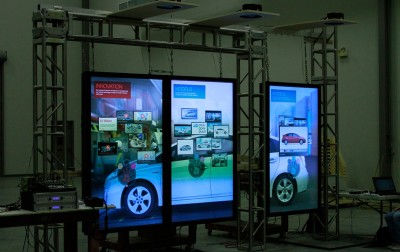By Jessica Webster
It has been a big year for interactive video walls, as more and more customers are adding them to their premises. Yet, to many professionals in the sign industry, interactive video walls still remain something of a mystery. To gain a better grasp of this larger-than-life medium, it is important to understand the various components needed to build the entire system, including touch-sensitive technologies, glass or plastic covers and installation and mounting equipment, to name a few.
Interactive or passive?
The first decision is whether or not the video wall should be touch-enabled at all, rather than ‘passive,’ for passersby. Converting an audience from spectators to participants can certainly improve the effectiveness of the media experience, but in some cases, it is not necessary to do so. The choice will depend on objectives and budgets—with passive video walls being the less expensive option.
Even if the goal is to create a ‘wow’ moment for the audience, interactivity may not be necessary. Some of today’s largest, most impressive and memorable video walls are eye-catching enough to command attention without facilitating direct interaction by touch.
That said, when a liquid crystal display (LCD) is placed within reach of passersby today in a public environment, they will usually try touching it. People today are coming to expect touch-based interactivity to be part of most of the screens they encounter, enabling a more personalized, dynamic and entertaining experience.
Touch technologies
Even when it is clear a touch-screen experience will best suit a project’s objectives, there are further decisions to be made, as that experience can be delivered in many ways. There are at least eight different touch technologies, some of which encompass multiple subcategories. Choosing the right one may seem daunting for a sign company that is new to the technology.
Fortunately, help is available to those who seek it. Some audiovisual (AV) integrators, for example, can train signmakers with the technology, so they in turn can communicate effectively to their customers.
Touch points themselves are a major consideration. If the on-screen content requires only mouse-like control by fingertip, then a simple single- or dual-touch configuration will suffice. On the other hand, if the content requires multi-touch gestures, like pinches, swipes and newer custom movements, then a minimum of six touch points would be recommended for a user’s hand. And if an interactive video wall will be used by several passersby simultaneously, then it may need 12 or 32 touch points to accommodate the intended experience.
One of the most well-rounded options in this respect is an infrared-based (IR-based) touch screen that can handle anywhere from two to 32 simultaneous touch points, for single or multiple users. It is more accurate than some other options and resistant to interference from higher levels of ambient light.
It is also worthwhile to take future-proofing into account. As the client’s business strategies change, technology will change even quicker. To make the initial investment yield continual success for the customer, the sign shop will need to try to anticipate future trends and developments. For the client who only needs one or two touch points today, a single-touch video wall may well seem ancient tomorrow, as people expect to be able to flick, pinch and swipe on-screen content.







